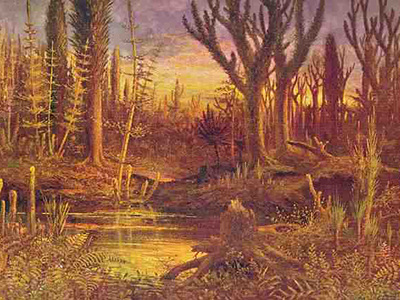Life, as we are inclined to picture it, relies on the existence of diversity in the world. The existence of different species makes it possible for living things to exploit different ways of making a living in the world. And that all stems from lineages to split and generate new species.

Major waves of diversification have occurred at various times in the history of the Earth; the Cambrian explosion being the best known. During the Devonian, a geological period between 419 and 359 million years ago, the surface of the Earth was colonized by green plants. The first forests arose as plants evolved the ability to produce wood. Later in the Devonian, the first seed-producing plants evolved. This period of rapid plant evolution and greening of the land surface is known as the Devonian explosion. This greening of the land surface of the Earth represented a huge increase in biomass, which triggered a major decrease in atmospheric carbon dioxide and increase in oxygen; this in turn triggered changes in ocean nutrient concentrations and cycling patterns. Although this topic was briefly covered in the article about the Devonian, Wikipedia had no article about the Devonian explosion until a student in Mitch Cruzan’s Plant Evolution class spun off a stand-alone about the Devonian explosion. By spinning off this article, the student editor was able to add a lot of valuable information to Wikipedia that would have unbalanced the main article about the Devonian, had it been added there. In addition, the creation of a separate article increased the visibility of this information as a plant biology topic, as distinct from the parent article about a geological period.
Life on land posed a variety of new challenges for plants including the need for support (air is much less buoyant than water) and reproduction. In the water, it’s possible for sex cells to swim from male to female, but this doesn’t work so well on land. Beyond this is the fact that although reproduction in plants is superficially similar to reproduction in animals, there are actually two separate generations – a haploid gametophyte generation and a diploid sporophyte generation. As plants colonized the land there was an evolutionary trend towards endospory – the retention of the gametophyte generation within the sporophyte generation. While this important process was mentioned a few times in Wikipedia prior to this term, the creation of the endospory in plants article by a student in this class filled a major gap in Wikipedia’s coverage.
People often think of species as distinct entities that are unable to interbreed or, if they do interbreed, the resulting offspring is sterile (like a mule). In reality, a lot of species are capable of interbreeding; a group of species that frequently engage in natural hybridization is called a syngameon. As hybrids back-cross with members of their parental species, genetic material can be exchanged between species, a process which is called introgression. Introgressive hybridization in plants is especially important because of its use by plant breeders to improve important crop species like wheat and ornamental species like daffodils. Student editors in the class were able to create new articles about these two topics; while the syngameon article is entirely new, Wikipedia already had an article on introgression, but its section on plants was just two sentences long. With a broad topic like introgression, it can sometimes be difficult to decide whether you should expand a section of an existing article or create a new daughter article, but in this case the importance of introgression in plant breeding makes the creation of a new article a very reasonable choice.
Student editors in the class also created articles on related topics like transgenerational epigenetic inheritance in plants, pollinator-mediated selection, photoautotrophism and temporal plasticity, while others expanded the developmental selection and heterospory articles. Advanced undergraduate classes like this one can bring the ability to recognize — and fill — important gaps like this one to Wikipedia. Without their participation, lacunae like these might otherwise go unnoticed.
Interested in improving Wikipedia in your subject area? Visit teach.wikiedu.org for more information on how to use Wikipedia as a teaching tool in higher education classrooms.
Image credit: Eduard Riou (1838-1900) from The World Before the Deluge 1872, United States, Public domain, via Wikimedia Commons
